I’m thinking about weirdos right now. Not the people panicking during these unprecedented world times, but rather weirdo revolvers. This doesn’t mean that I think weirdos are bad or good, inferior or well-made, it just means that they’re out of the norm as self-defense handguns. They’re just weird.
Growing Up “Weird”
In the personal little gun world that I grew up in, I was exposed to top quality firearms from all the name brands in the early 1970s. My dad was a gun collector and bullseye target shooter. My grandfather was a bird hunter and worked as the gun buyer at Marshall Field and Company in Chicago. They both had an affinity for the best that firearms had to offer, whether they were shotguns, rifles, or handguns.
Smith & Wesson and Colt were the big names if revolvers were your thing. You were either a Smith guy or a Colt guy, just like being a Ford or Chevy guy. Ruger was the upstart and Astra, Charter Arms, Taurus, and Webley were considered third rate.
While my dad had high quality guns secured in his safe, I got to play with two little British Bulldog double action revolvers when I was a youngster. Yep, real guns with their firing pins removed. The weird European cartridges they took were unavailable here in the USA, so that made them a bit safer in addition to their lack of firing pins. Both were nickel-plated and fit my kid hands well because they were small framed with black hard rubber grips. They had terrible triggers, but they did go click-click and that was good enough for me. I have no idea where my dad got them, but I do know that they were really weird.
Break Tops
My dad collected break top revolvers for a few years, focusing on the models made by S&W, Harrington & Richardson, and Iver Johnson. All three of these late 1800s pocket revolvers were very well made. They were precision made and hand finished examples of mechanical excellence. These top break revolvers continued into the early 1900s and featured a hinge at the forward lower portion of their frame. The barrel and cylinder tilted forward and down while ejecting its chambers and providing for a reload.
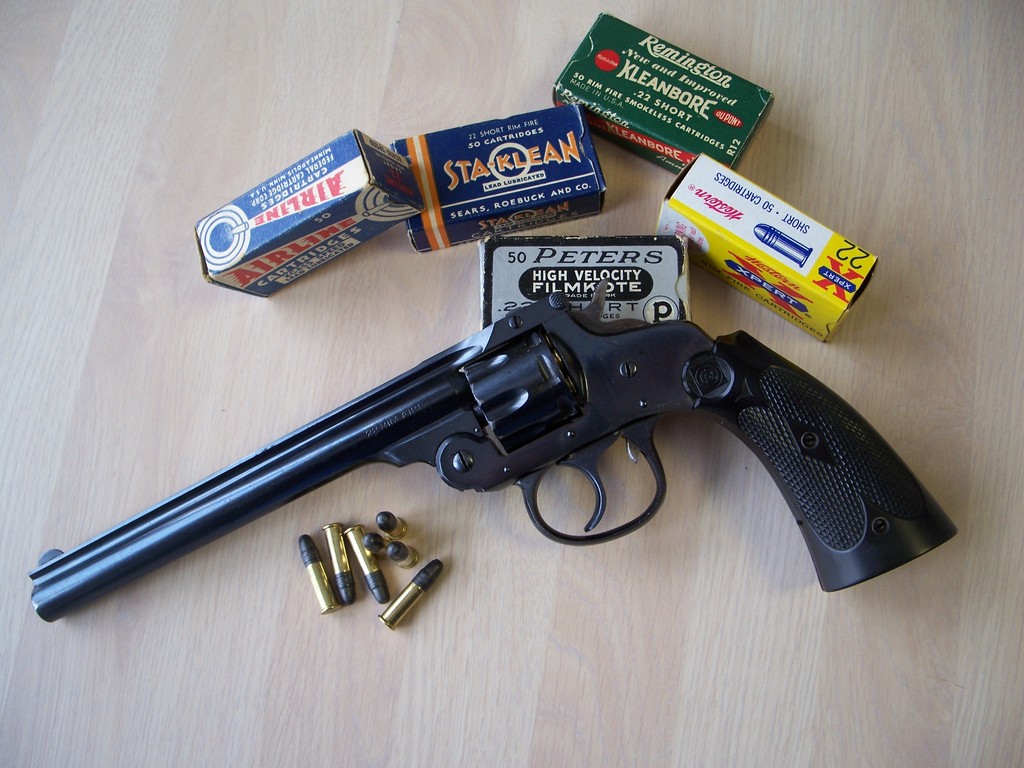
My father had all three brands (he shied away from “lesser” manufacturers like Forehand & Wadsworth and Hopkins & Allen, but they’re really not so bad either) in both .32 S&W and .38 S&W caliber. Both calibers were usually a five shot, but there were some six shot .32s made on the larger .38 frames. All three brands came finished in gorgeous polished blue or nickel plating. The double action top breaks came with either exposed hammers or “hammerless” (concealed) versions. The S&W hammerless revolvers had grip safeties and were referred to as “lemon squeezers” since the device bore a resemblance to actual lemon squeezers in the kitchen.
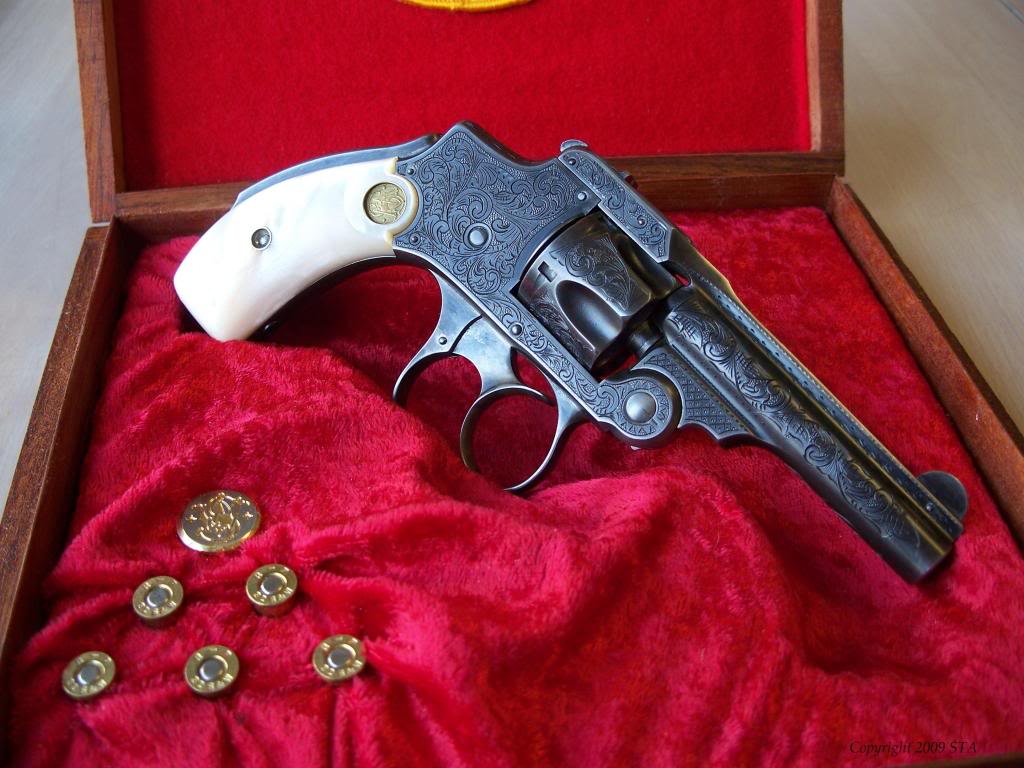
Grip material was a hard rubber called gutta percha, but many of these pocket revolvers were dressed up from the factory or aftermarket with mother-of-pearl handles. Sights were tiny and almost useless in a gunfight.
As the years progressed, new models like the S&W Hand Ejector arrived with swing out cylinders. There was a short period of time (1909 – 1920) when the S&W Perfected Model .38 was offered. It combined the break top’s tiny release latch at the rear sight area with a cylinder release latch just like the ones utilized by current S&W revolvers. This transition gun is a unique collectible for those who appreciate it.
Break tops function and perform well. Their mechanics work with springs that still reliably strike primers. At 7 yards and under, they are rather easy to hit with, even thought their rudimentary sights are often lost in bright sun, cloudy days, or darkness. Cocking the hammer on exposed hammer models provide a decent single action trigger, even though most of our hands have a difficult time properly holding the tiny frames and grips.
Shooting these guns can be fun, though their cartridges are wholly underpowered compared to today’s modern choices. Caution should be taken to only shoot guns with decent bores and mechanics. Smokeless power usually mandates use in only modern firearms, but I have found old factory .32 S&W and .38 S&W ammo was loaded so weakly that it is still okay to shoot in black powder cartridge break tops from the mid to late 1800’s pre-smokeless days (smokeless powder came out in 1894, but black powder was still loaded into cartridges into the 1930s). Even today’s production cartridges in these calibers are made knowing they might be fired in antique revolvers, so it’s loaded weak. Always check and make informed decisions before shooting one.
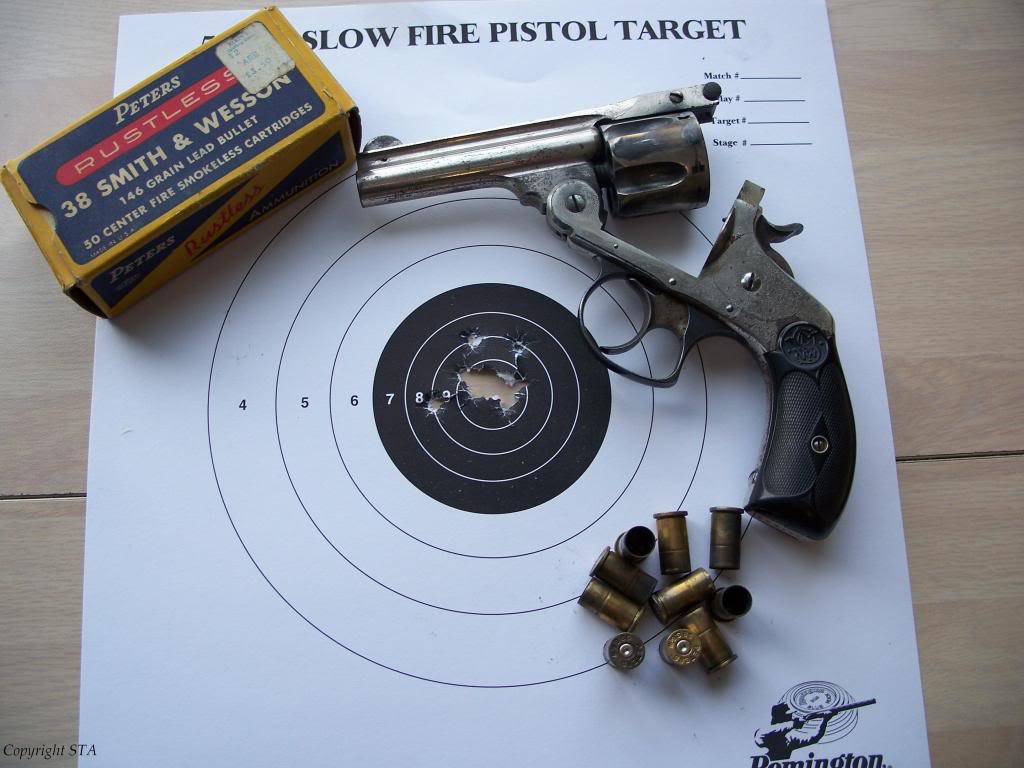
But shooting them for self-defense is still a possible consideration. We often talk about stopping power and underrated cartridges and make statements like, “I wouldn’t trust that wimpy pipsqueak of a round!” Usually we are thinking of a one-on-one pistol fight to save our life during a mugging/robbery/home invasion. But weirdo guns may be a reality for actual use for certain occasions, including today’s unprecedented events. Perhaps you have a little break top and a box of old ammo that was given to you, inherited, or picked up cheap sometime in the past. You still have your carry revolver or pistol, but now you want a New York reload or even the ability to arm another family member during an emergency.
Weirdo guns to the rescue! Again, not saying they’re good, and maybe they’re not your first, ideal choice. They’re just a little odd… or weird.
Oldies but Goodies from Across the Atlantic
I was gifted a Manufacture d’armes de Saint-Étenne six shot revolver chambered in 8mm Lebel many years ago. This French handgun is a Model 1892 double action and it states right on the barrel that it was made 128 years ago in 1894. Wow! The machining is stunning! It’s overbuilt like a tank with a half octagon, half round barrel with a bead front sight machined as part of the entire barrel. The cylinder opens to the right after pulling back a huge knurled lever on the right side of the frame. When it swings open on its yoke, the fit of the parts feels like a bank vault door yawning wide on precision made hinges.
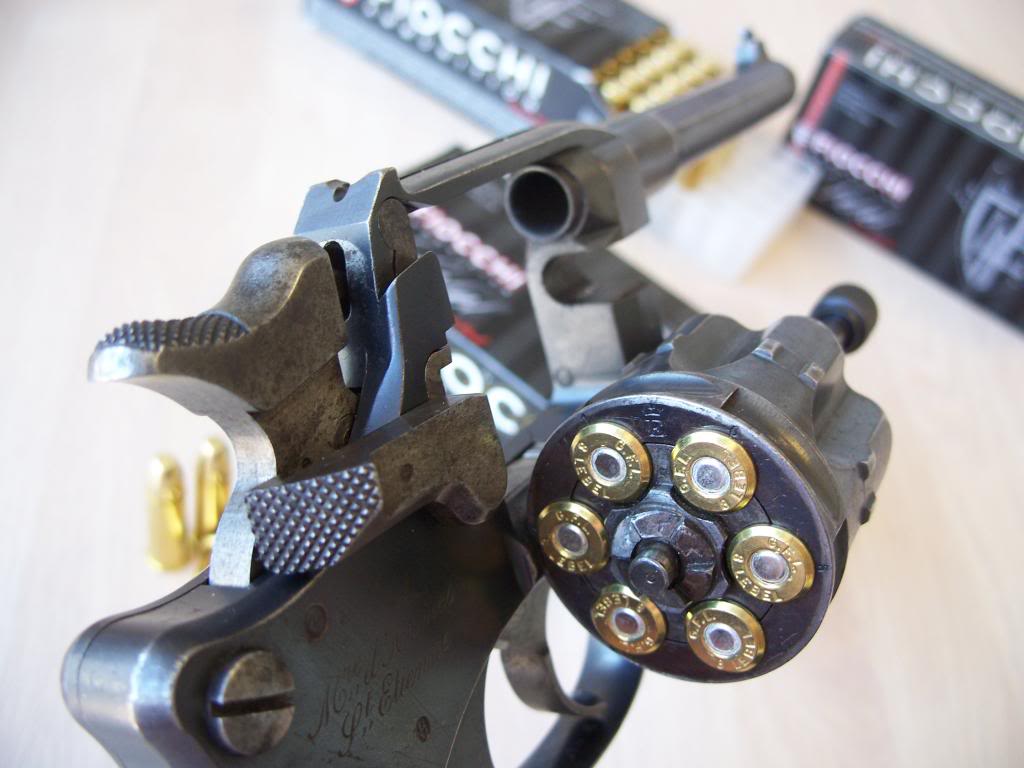
The gun’s grip looks skinny and…weird. The balance looks all wrong because my eyes are used to American made S&W and Colt wheel guns. For most of us, our American revolvers require grip adaptors or oversize stocks to fill in the area behind the trigger guard. They don’t really fit our hands very well. I was surprised to find that the ergonomics of this century and a quarter old handgun were perfectly formed for my large hands.
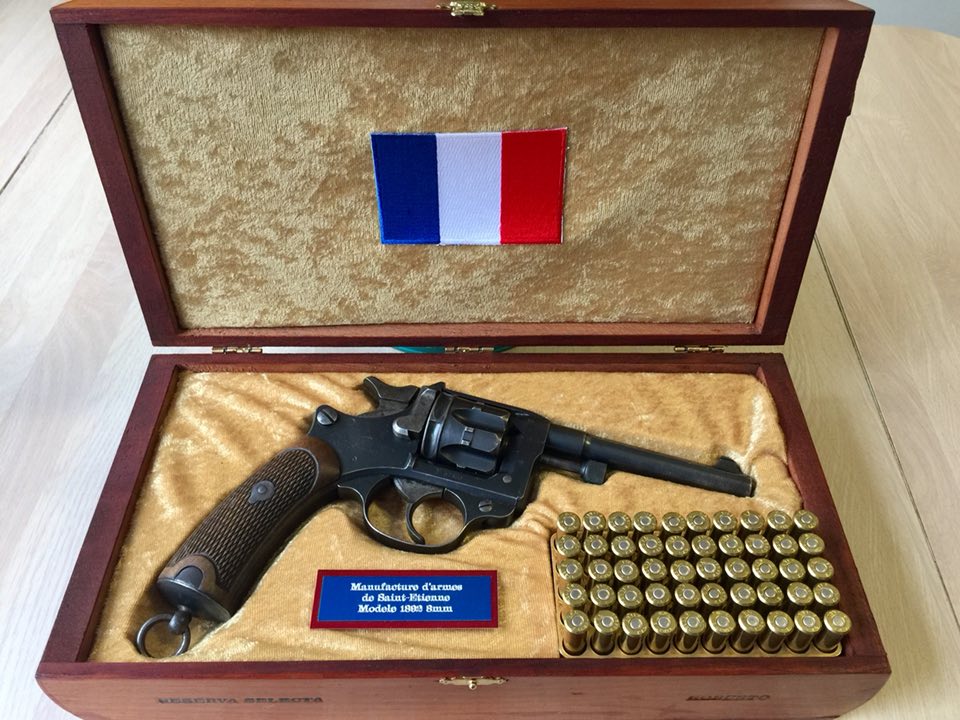
The MAS 1892 points intuitively and feels terrific in either a one handed or two-hand grip. Inspecting the checkered wood panels closely, they have no grip screws. They slide on and are dovetail hand fitted to each pistol flawlessly. Today’s manufactures cannot achieve this level of fit and finish without time consuming and costly hand fitting. Back in the day, this attention to detail was common.
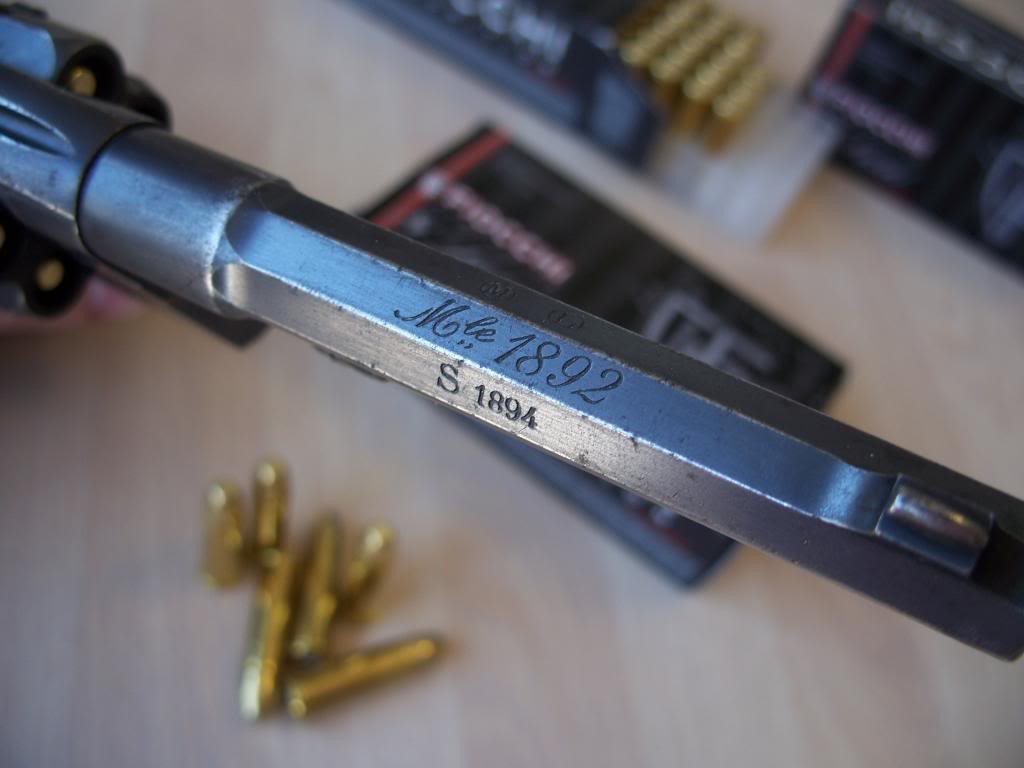
The MAS 1892 has a large screw on the top right side of the rear of the grip frame. Turning it with a fitted screwdriver causes the left side of the grip frame to slowly space itself away from the main frame on a hinge that pivots forward of the trigger guard. The entire trigger guard and sideplate swings away and forward to expose the mainspring and internal workings of the trigger and hammer mechanisms. Parts are even numbered in order of how they should be removed for extensive cleaning. It’s truly remarkable and bewildering genius from the 1890s.
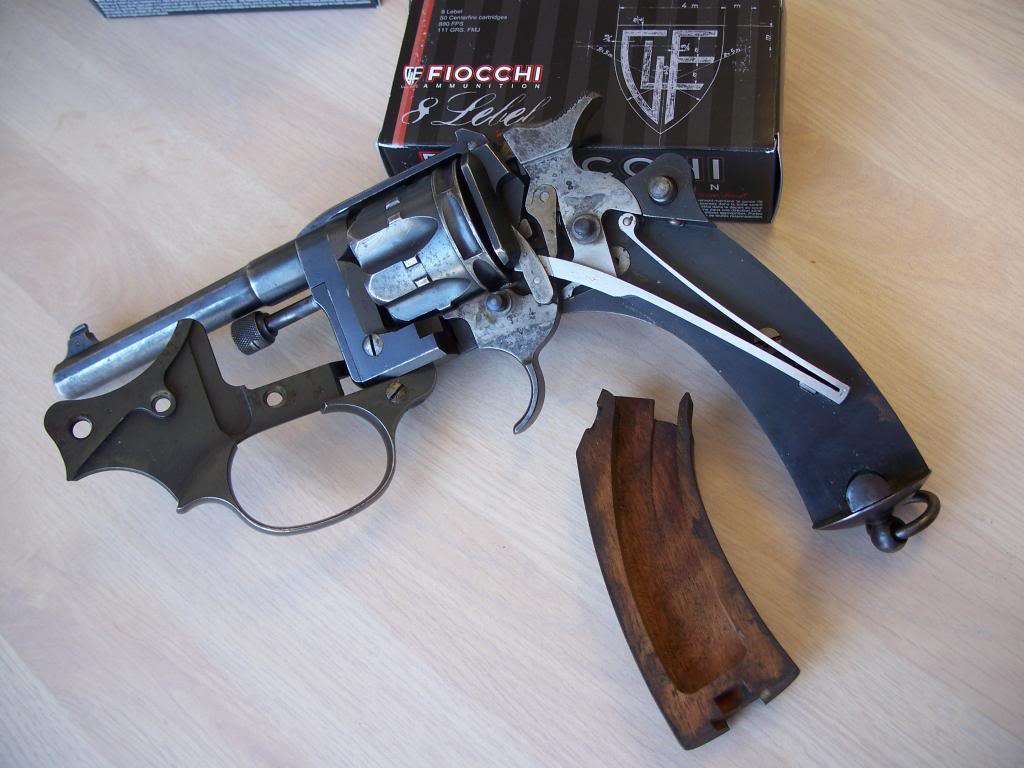
The double action trigger pull is smooth but heavy, while the single action trigger pull is crisp at around 5 pounds. Fiocchi still makes 8mm Lebel ammo for this gun today and recoil is minimal. The MAS was found to hit dead on at 25 feet with this ammo, which impressive with fixed sights.
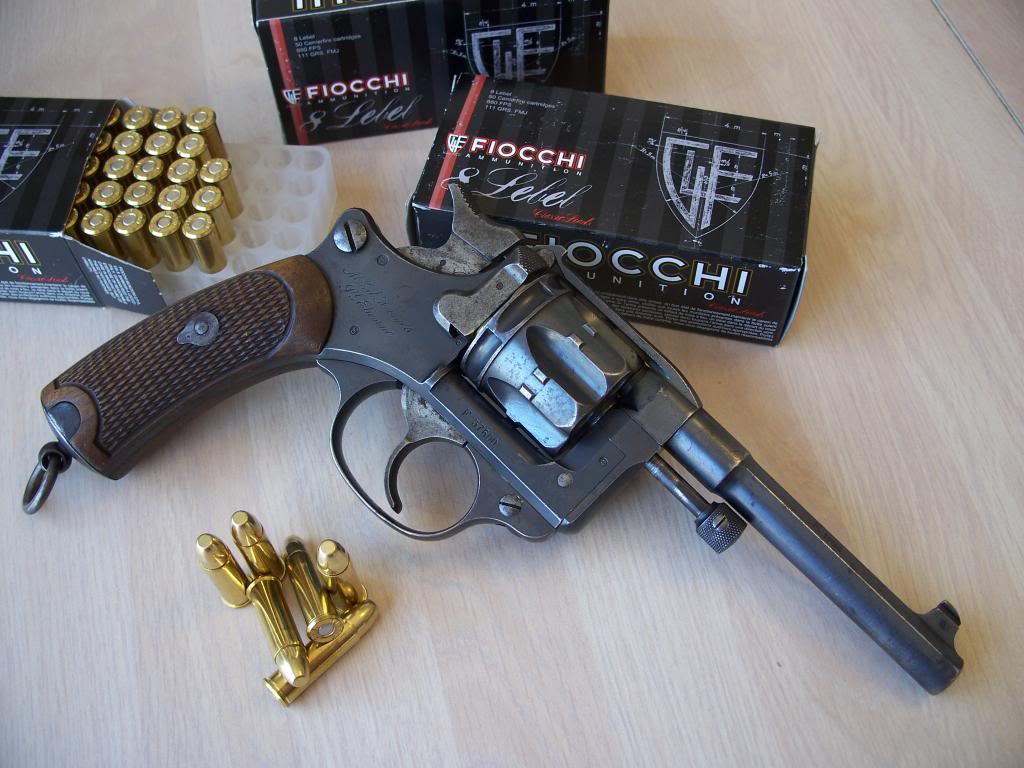
This is a gun many would walk right past at a gun show table or in a gun shop’s display case. If you see one, ask to check it out and you’ll find yourself impressed as you handle it…even though it’s weird.
Weird Cartridges, Too
S&W has chambered I- and J-frame double action revolvers in .32 S&W Long forever. I was gifted an unfired one that was new in the box and sported a 4-inch long barrel. That makes this a doubly weird revolver. A J-frame in .32, instead of .38, and with a barrel two inches longer than the standard 2-inch version.
It’s a Model 30-1 Hand Ejector and its polished blue finish is gorgeous, like all pinned barrel S&Ws from back in the day when guns were truly blue instead of black. The old style dark blue cardboard box is a friendly reminder of the good old days.
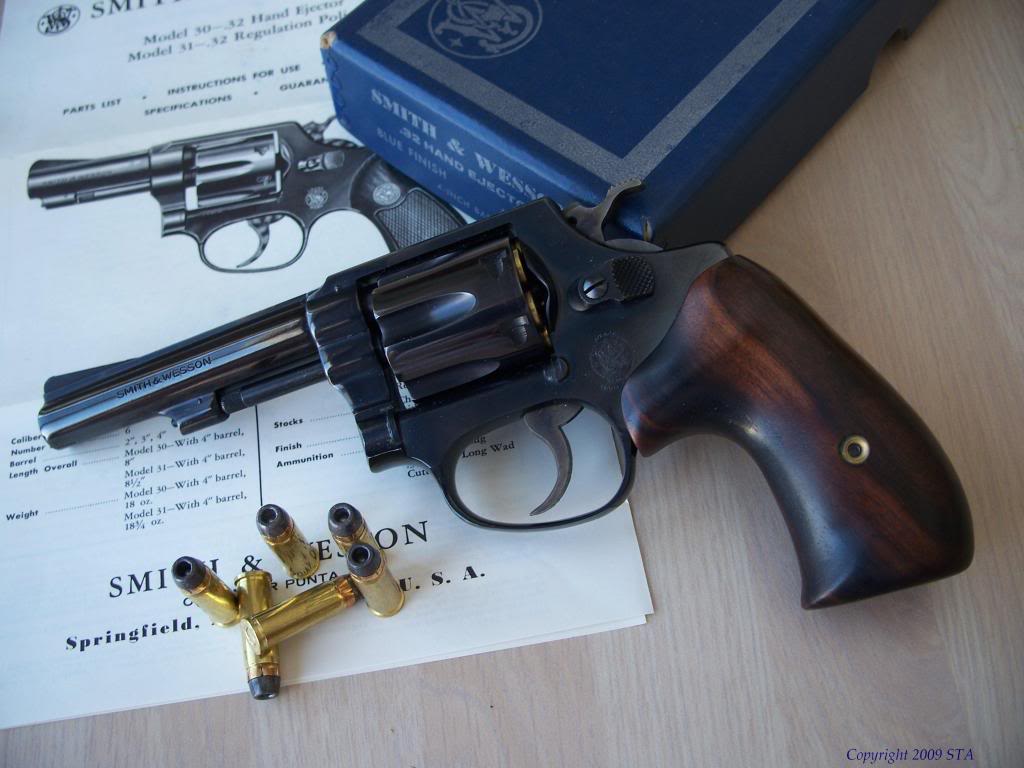
My dad used to have an original S&W .38 Chiefs Special flat latch and he made a set of beautiful wood stocks for it himself. It’s the only pair of grips he ever made. I’m not sure why he never did it again because they are amazingly well fitted and proportioned. My dad had small hands and I have large hands, but these grips still fit my hand well. There is a little nub at the front of the bottom of the grip that locks in my ring finger.
The sights are fixed and very low profile. I bet this gun shoots great, but I have yet to bring myself to shoot it as I received it unfired. The .32 Long is a nifty little cartridge in this 4-inch barrel for shooting small game, but I would prefer a .38 Special if I had the choice. But if I didn’t have the choice, this .32 would still be an option.
I reviewed the Charter Arms Pitbull 9mm revolver here on RevolverGuy a little over two years ago. I also had a .40 S&W model come through my hands a few years before that as well. The .40 was a weirdo gun.
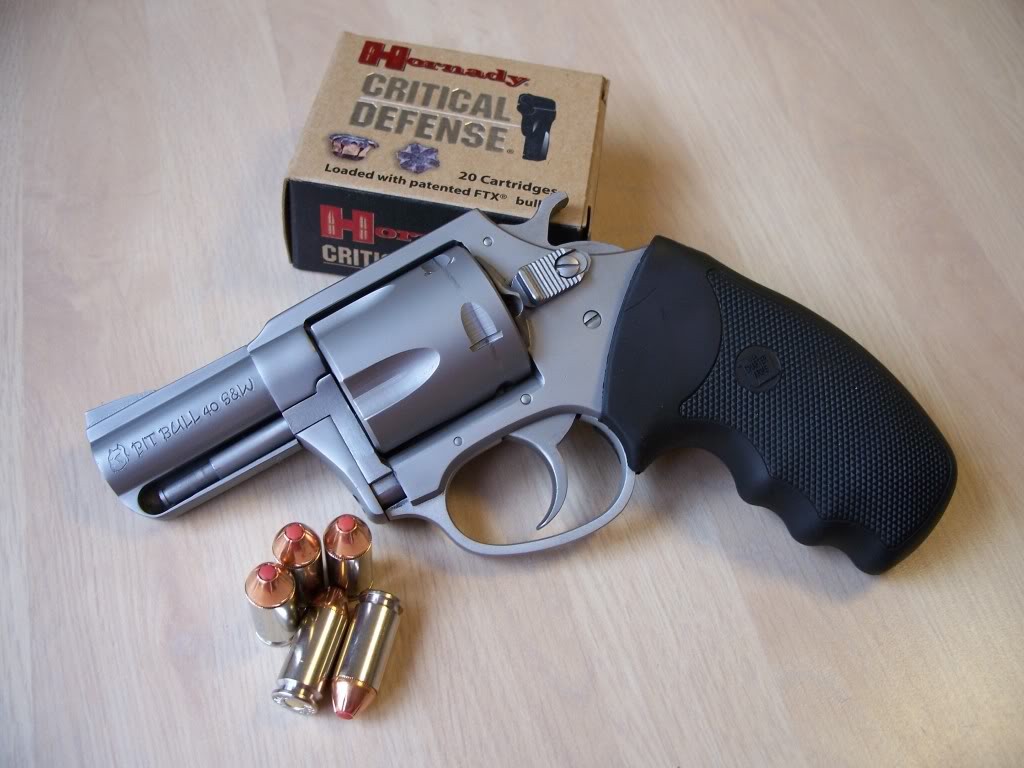
The Pitbull has small spring loaded clips in each cylinder chamber to retain rimless semi-automatic cartridges, eliminating the need for moonclips. Available in 9mm, .40, and .45 ACP, each caliber packs a heck of a wallop. I found the .40 S&W to be abusive in both felt recoil and muzzle flash. The recoil was worse than any .357 Magnum or even .44 Magnum snubby I had ever fired. There is just something about the powder burning speed of the .40 S&W semi-automatic cartridge when it’s fired in a short barrel revolver. Muzzle flash from the unburned powder was blinding, even in daylight.
I asked a friend to try the gun and he fired two shots and said he was all done. He couldn’t keep a two-handed grip on the Pitbull after pulling the trigger due to the violent recoil impulse.
While the cylinder’s spring clips allow the revolver to load, fire, and eject like any other gun chambered for revolver cartridges, it is a little bit weird. Combine that with a caliber as hot as the .40 S&W (with full power factory loads) and this Charter Arms model is a weirdo in my book.
Single Actions
Single action revolvers have long been used for self-defense, going back to the civil war (black powder) and the good old cowboy days of the 1870s. Other than slow reloading time (ejecting spent cases and inserting live rounds takes forever and a day by modern standards), the single action revolver offers an ergonomic grip and a somewhat easily accomplished thumb cocking technique.
The Single Action Army Model 1873 by Colt points very naturally and is an inherently accurate revolver. The New Frontier version was Colt’s adjustable sighted style for target or long range shooting introduced in 1961. The cowboy gun had grown up into a respectably accurate shooter with this variety. Offered in 4 ¾-, 5 1/2-, and 7 ½-inch barrels, the tall front sight looks a bit ungainly, but it matches up well with the fully adjustable rear sight.
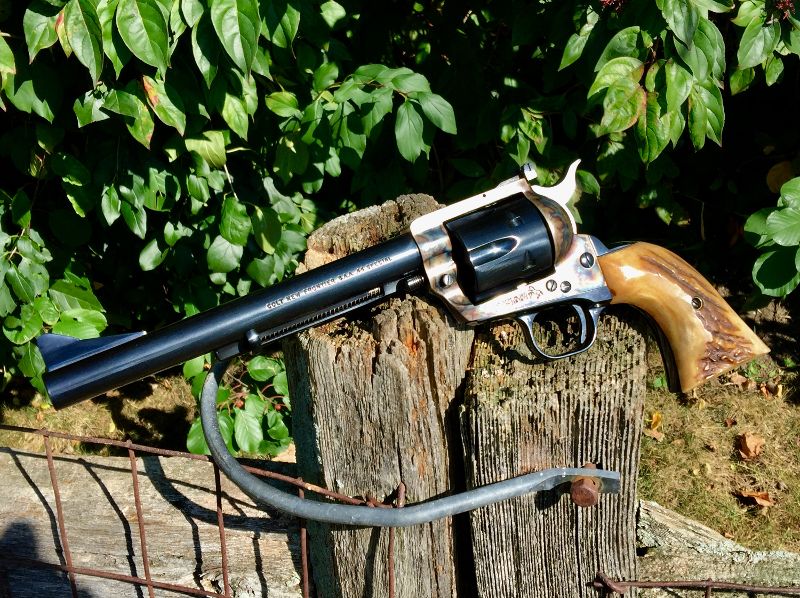
Colt’s blue and casehardening has always been something to covet, but Jeff Quinn of Gunblast.com caused me to laugh so hard it hurt when he wrote in his review of the current New Frontier, “I have seen prettier wood on a Chinese shipping crate….” I don’t know why Colt has always used cheap looking walnut on these guns, but my early 1980s model was seriously afflicted with the crappy wood. My dad owned a set of Sambar stag from India that hopped from Colt SAA to Colt SAA as he horse traded revolvers in the 1950s and 1960s. I still have the stocks and they have settled on my .44 Special 7 ½-inch New Frontier. It is a real shooter at any distance and all kinds of fun on steel plates at 100 yards.
My eyes are so used to the graceful lines of the original 1873 however, that the Colt New Frontier, with its flat top frame and gigantic adjustable sights looks a bit weird to me.
Sticking with Colt single actions while we’re on the subject, the Colt Frontier Scout came out in 1957. It was a sixgun made slightly smaller in stature to the original Model of 1873 and chambered in .22 long rifle. Colt made a commemorative version for just about every event in US history and for almost every state.
I was looking for a .22 single action to buy for my daughter when she was 12 years old. I was considering a new Ruger Super Single Six for around $499 out the door.
I went to a gun show and a guy had a four-gun set of Colt Frontier Scouts in the Lawman Series displayed on his table for sale. The Wyatt Earp model had a 12-inch barrel (super weird!) and a black frame with nickel everywhere else and a set of those ugly Chinese shipping crate walnut stocks.
The Pat Garrett model was hideous in two-tone gold and nickel with fake plastic pearl handles and a thankfully short 4 ¾-inch barrel. The Wild Bill Hickok single action had a weird 6-inch barrel and was finished in an ugly black and nickel with those same horrible fake pearls.
But the Bat Masterson (a gentleman known for his stylish bowler hat and mustache) commemorative was all nickel with black gutta percha hard rubber handles and unfired since being made in 1967. It came in a black leatherette covered presentation case with a red silk lining. The outside of the case had a facsimile of Masterson’s famous handwritten letter to Colt describing the gun that he wanted them to make for him (a .45 that looked just like this nickel plated .22).
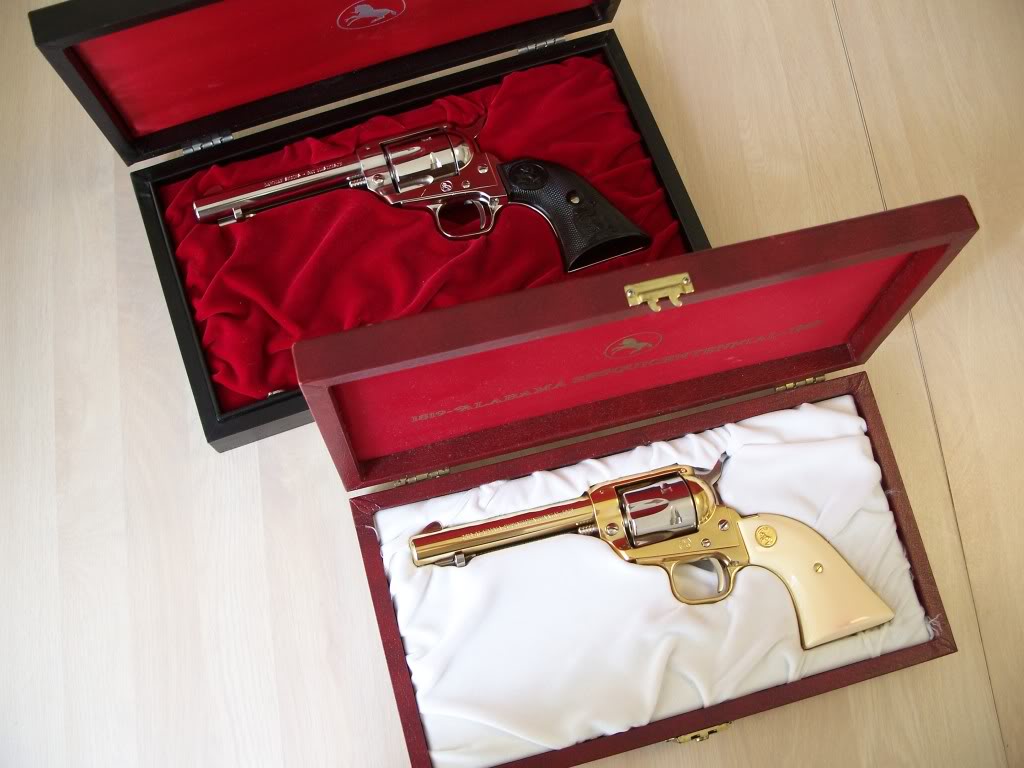
It was unfired and the asking price was $445 out the door. The guy broke up the set and sold me just the Bat Masterson single action Frontier Scout. My daughter still has it today.
A year or so later, I stepped up to a display case at a gun shop I was picking up a gun I had won in a police match raffle and saw another Colt Frontier Scout just like the one I had purchased for my daughter. She was going to Cowboy Action Shooting matches with my wife and I and another Frontier Scout for only $400 like the one offered before me would make a nice match. It was an Alabama Sesquicentennial Commemorative from 1969 and it was unfired. It had gold and nickel plating with faux ivory grips. Weird indeed.
I asked to see it and the salesman removed it from the case. A zip tie held the hammer from being cocked. I asked if he could remove it so I could make sure the action worked properly. He had a jerky attitude and said he would not remove it because cocking the gun would scratch the cylinder. I paused and stared at him for an uncomfortable amount of time to make my point. Then I bought the gun.
I returned three days later to pick it up and the same jerky sales guy completed the transaction. I cut the zip tie with my pocket knife and opened the loading gate with the hammer on half cock and checked to be sure it was empty. I then closed the gate and looked him in the eye.
Without removing my gaze, I began cocking and lowering the hammer with the muzzle pointed down in a safe direction. I did it a lot. I asked him, while still looking at him and not the gun, “So you said that cocking this revolver just like this will cause the bolt to scratch the cylinder? “ I kept doing it.
He said, “Uhhh, yeah it will.”
I replied, while still cuh-click, cuh-click, cuh-clicking the hammer, “This gun was made by Colt in 1969. Even a .22 single action like this didn’t leave the factory back then without a perfectly timed action. The bolt comes up at just the right moment and does NOT scratch the cylinder. See?”
I offered him the side view of the nickel plated cylinder, still unmarred, then I left with my weird little .22 single action that my daughter shot for years.
Colt came out with their Open Top cartridge revolver designed in 1871. It was only made for two years and ceased production in 1872 when the SAA came out the next year. While it was a cartridge revolver, it retained the handsome lines of the black powder revolvers that preceded it. The open top frame gave it its nickname.
While the originals by Colt were chambered in .44 Henry rimfire, Italian gunmaker Uberti began making a modern replica for Cimarron chambered in .44 Special. While not meant for Elmer Keith’s powerful handloads, it can handle Cowboy Action loads and I had a desire to get one as soon as I heard they had been released (other calibers had already been available prior to the .44 Special model).
From previous experience, I knew that the hammer and trigger would be rough and heavy. I ordered one of the Cimarron guns from my local Bass Pro Shops store with the idea of sending it to Bob Munden as soon as I received it. I did just that too. I only cocked it a few times to prove myself correct that it needed work, then shipped it off to Montana.
Bob Munden was known as the Guinness Book of World Records Fastest Gun Who Ever Lived. I used to watch him on Shooting USA on television with my dad. Munden had a wry sense of humor that not everyone quite got, with quotes like, “I’d be humble if I had a reason.” I sent him my new Cimarron 1872 Open Top for his Option #1 action job and 11-degree forcing cone cut. As long as the gun was there, I wanted it permanently proven that it was worked on by Munden himself, so I opted for his barrel engraving, which reads, “Custom by Bob Munden.”
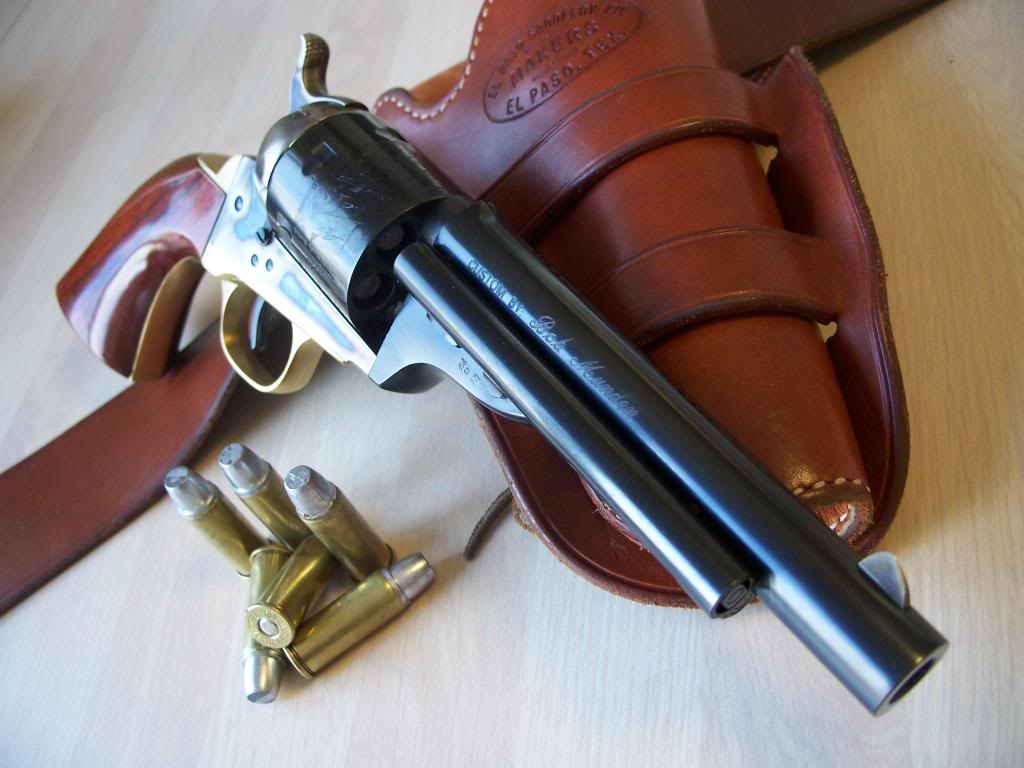
The gun was away for a while and I came home one day from work to find a message on my answering machine. I pressed play and heard the famous voice just like I had heard him say on television so many times, “Steve, Bob Munden here….” He went on to say that mine was the first 1872 he had worked on and that it was likely to be the last. Because the bottom of the inside of the frame is concave instead of flat, he couldn’t see the bolt move up into the cylinder notches when the hammer was cocked. This meant he had to work on the action and then keep taking the gun apart and putting it back together to get it just right.
When I did get the .44 back, the trigger broke at 1½ pounds and the hammer cocked super light and smooth. The trigger is almost…almost a bit scary. But in all these years, it has held its action’s edges sharp and the guns shoots amazingly well. Sadly, Munden passed away a short time after I received my Cimarron from him. I am forever grateful that I made the decision when I did to have him perform his work on my gun.But even the Fastest Gun Who Ever lived pretty much said it was a weird revolver.
Tiny Weird Revolver
My dad bought one of those tiny North American Arms Mini Revolvers chambered in .22 long rifle many years ago. He bought it because he found the design fascinating. It’s a little single action five-shot made of stainless steel. It has a spur trigger. Loading and unloading is accomplished by first removing the cylinder pin. Then the cylinder will drop out of the frame. You need something to punch out the fired cases and that object must be thinner than a pencil to fit the .22 chambers.
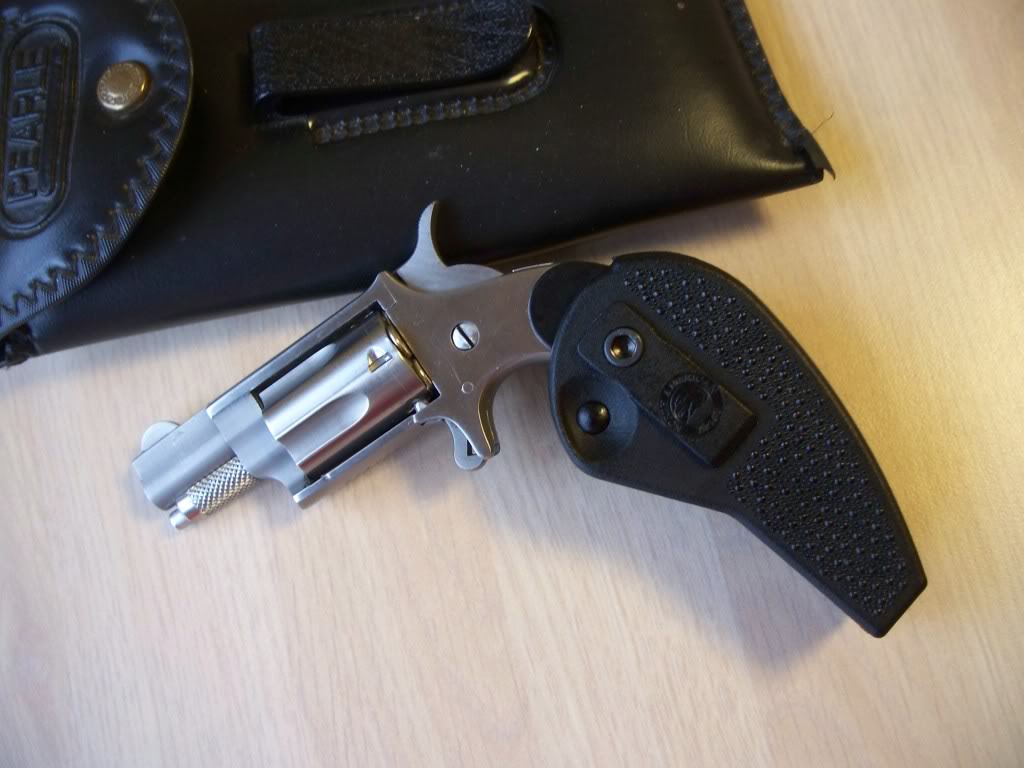
My dad actually carried the tiny thing in a Pearle Vision eyeglass case in his breast pocket. No one ever knew he had a gun on him. The .22 fired out of a short 1 5/8-inch barrel doesn’t have a lot of oomph, but it’s still better than a pointed stick. It’s also hard to hold and fire without the extended, rotating belt grip. With this grip however, it’s much closer to the handling feel of a standard single action. Sights are useless, but it does point well.
As a last ditch weapon for deep concealment, the NAA Mini Revolver is a gun that even my dad knew was weird. But he also knew that it served a purpose. Freedom Arms really re-invented these tiny revolvers, taking from designs in the early 1800s, and even made those belt buckle mounts for them that I thought were cool when I was a kid. Well, cool but also really weird to have a fully functioning gun on your belt buckle.
Remember, weird guns are not necessarily bad. They can still provide a modicum of self-defense in a pinch in a world gone weird. They might even be the gun you provide to someone who needs a gun if the world gets any weirder. Just follow all of your local and federal laws for legal transfers. If there is any local or federal law left after all this weirdness.

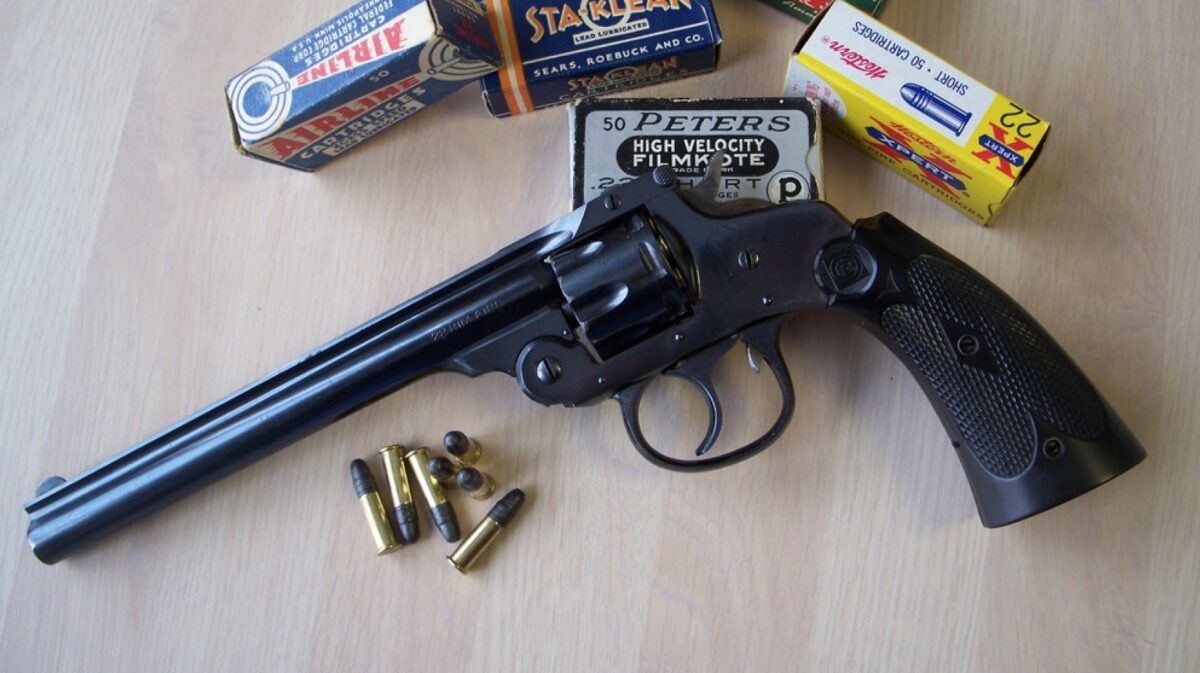
Thanks for an interesting read… I too enjoy some of the oddities of the revolver world. Lately it’s been .32s where I can find them. Which leaves me just a little jealous of that 4 inch J frame, it’s beautiful! The grips are outstanding, I might try making something similar someday. Thanks again for the article and pictures.
I passed one up a few weeks ago for under $300 and I’m seriously regretting it now!
About 20 years ago, we tried to get my mother-in-law to shoot .38 special. My wife, about her mom’s size, handled our snubby fine…not a gun that I would choose for home defense now, but we were not well informed when we got our first handgun at a good price from a friend.
“Hurts to shoot,” mother-in-law declared, even after shooting mild loads, and her husband went in search of something softer. I was with them at a gun show when they found a Colt, nickel plated with mother-of-pearl grips, at a good price. It was weird to me, having never even heard of .38 S&W.
But the gun was her choice and she shot it really well, until the day she passed. It is with one of her sons now. If you shoot something well, I have said since then, that is the gun—weird or not—to use in a pinch.
I enjoyed ur article, i have had a few of the old owlshead s@w, forehands, they were fun to shoot
I’ve got a fixation for the open tops, I have an 1851 Navy that shoots 44 round ball,not historically correct but it sure is fun.
I bought a little NAA 22lr a few years ago at an auction and it’s one of my favorites.
Thanks for a weird read!
What a delightful read, Steve! Thanks for sharing all these weird guns and GREAT stories with us!
I’m especially intrigued by that MAS 1892. What a fascinating design! The gun serves as a monument to precision machining, for sure. Just trying to time that screw for the sideplate would be a monumental job, but looking at that barrel—with the octagonal-to-round transition, and the front sight milled from the barrel blank—really gives you an idea of what they accomplished. Very neat, and also a little weird.
I don’t think I’ve ever seen a break top as handsome as that Gouse-engraved, Lemon Squeezer. Wow! What a beauty.
The two highlights for me though, were:
1. Those beautiful stocks that your dad made. Wow! Just looking at them, I can sense how great they would feel in the hand, and they’re certainly handsome. I too, wish he had made more!
2. Your story about the cylinder scoring (or lack thereof) on the Alabama Frontier Scout. I grinned ear to ear, thinking about you staring down that dealer with a steely gaze, as you cycled that action! I’ve got this inescapable vision in my head about how Clint Eastwood would have scripted and played that scene. Eli Wallach’s got nothing on you!
Riley: Thanks! I’m glad to have provided something interesting, exactly my goal. .32s sure are all kinds of fun!
Justin: $300? Such a deal!
Frank: Those “owl head” Iver Johnsons had transfer bar safeties too. Their tag line was that you could “hammer the hammer” and it still wouldn’t go off accidentally.
Bitter: There is really something graceful and handsome about those 1871-72 Open Tops, right? The NAA .22s are neat little (emphasis on little) revolvers.
Mike: Thanks! That MAS 1892 amazes me every time I pick it up. The design and workmanship is stunning by today’s standards, let alone from 125 years ago! I came across those factory S&W pearl handles on a gun that was going to be destroyed. I removed the grips, they were too nice to let be lost. I looked for just the right gun to put them on when a great deal fell in my lap on the old breakup they’re on now. It wasn’t a pretty gun with a terrible nickel finish, but I sent it to Gouse for engraving and blueing and asked him to make it NOT look brand new. I’m very happy with how it turned out. I used to carry that pearl handled S&W lemonsqueezer in a floral carved suspenders holster during cowboy action shoots. I need to find a .38 J-frame to put my dad’s homemade wood stocks on so I can shoot it. Glad you liked my gun store story about the Alabama Colt. We all know someone like that at the gunshots we frequent I think. Many people don’t know how to properly thumb the hammer of a Colt without scratching the cylinder. It has nothing to do with actually cocking it, but rather “how” it is cocked. I know Mike knows this, but for anyone else who happens to not know, thumbing the hammer all the way back and then easing the hammer back all the way down with the trigger depressed is the proper way to work the action of an unloaded Colt SAA. Any stopping or starting halfway in the middle causes the bolt to lift up and score the cylinder.
NAA also made a black powder version of their micro-revolver. I got to shoot one once. Highly amusing. Using it would be like a squid shooting ink. You’re supposed to escape in the confusion before the smoke clears.
My dad and his dad were both lawmen down in Tennessee….my dad was born in 1903, my grandfather in 1870. Both carried a break open S&W 32 caliber revolver in their pockets. My dad told me once that everyone knew he was the law and there were rarely any confrontations. However, if they expected trouble they went and got a shotgun. My dad passed away in 1997. He always had a problem with cops being all tactical for normal duty…He felt it escalated things. He never even wore his gun on a belt, nor did his dad…different times for sure. My sister ended up with that revolver but I don’t know what ever happened to it after she passed away. It had white grips, but they weren’t ivory or anything exotic.
It’s important to remember that almost any gunshot wound prior to the advent of antibiotics had a good chance of being fatal. So even a pipsqueak .32 would get your attention.
Critch, it’s always great to be reminded of police work from another era. Simpler times when respect was the norm. You’re absolutely right about no one wanting to be shot with anything!
Lee, that’s funny! I love that!
Critch, good to have you join us here. That’s a neat story about your dad and granddad. Different times, indeed! I’m sorry you lost track of that gun–would have been neat for you to pass on, but at least you have the memories and stories.
Excellent writeup. In our present time when arguments over this or that round being the best for self defence are endless, it is always interesting to pause and look back in time and see what generations in days past viewed as adequate self defense rounds. Can we even imagine the day when the .38 Special had the ‘wow’ factor?
Alas, the MAS 1892 . . . probably just mere coincidence that the lockwork design of this revolver mysteriously reincarnated much of itself in Colt’s double action revolvers (Official Police and Police Positive lockwork) until 1969. Ooops, my bad, it’s come back again in the resusitated Python.
Steve,
My dad was in the USNavy in 1920 in Russia when he saw a Russian shoot himself in the head with a S&W breaktop 44. He ran over and grabbed the gun. He had it until the 60’s that I know of. I know he carried the gun as a BUG when he went big game hunting. I wish I knew what happened to that gun.
I like your writing and it’s informative, too.
Hank Mayer
The MAS 1892 revolver is very common here in Brazil, because they were standard issue in some State Police Departments, like São Paulo Public Force, in the beginning of 20th century – our Army and State Polices were trained by French officers at that time, while our South American neighbors, like Bolivia, Paraguay and Chile, were treined by the Prussians.
But its ammo was never made here, being all imported from France, made by Societé Française de Munitions (SFM). Many of these revolvers are damaged by improper use of .32 S&W Long cartridge.
Other weird revolver and cartridges still common here are:
– “Velo-Dog” type: most are in the obsolete 5,5mm Velo-Dog, but there´s guns chambered for .22 Short, .25 and .32 Auto. The “Le Novo” revolver, 5-shot .25 Auto caliber with folding trigger and grips, is VERY concealeable. Some owners still carries these small guns.
– Nagant-type: Made by Simson, in Suhl, Germany, this revolver were the standard sidearm in the Brazilian Armed Forces in the end of 19th century and beginning of 20th. Cartridge is the .440 Brazilian Nagant (in really a .44 Henry Centerfire). Reloaders makes ammo shortening .410 brass shells.
– Girard: A under-break, self-extractor revolver, made by Jules Kauffmann in Belgium. Cartridge is the British .380 Short CF, no longer made since 1970´s. Experienced reloaders can make ammo for it.
– Orbea: Spanish copy of S&W .44 Double Action sold to British Army (in .455 Webley caliber) during World War One. After the war, some of these surplus guns were sold to |Brazil, and, later, converted to .45 Auto Rim.
Erick, it’s fascinating to hear how these cartridges and guns live on! I suppose they will continue to give good service as long as there are clever reloaders (and as long as the old parts don’t break). Thanks for sharing!
How about the revolver that doesn’t revolve? The colt camp perry